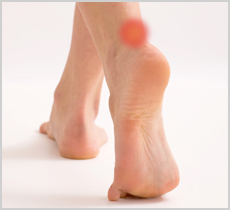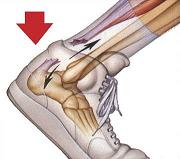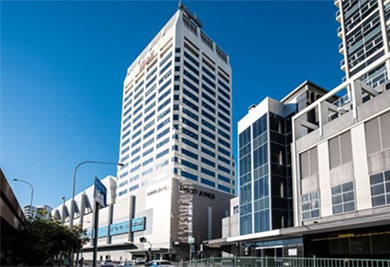What is Achilles Tendonitis?
Your Achilles tendon connects your calf muscles to your heel bone or calcaneus. It’s a vital muscle you use daily when walking, running, climbing stairs and other activities, so getting the best Achilles tendonitis treatment in Sydney is crucial to maintaining your active lifestyle and getting the most out of every day.
Achilles tendonitis is the overuse and overstretching of the Achilles tendon and its covering. Due to the repetitive action and its response to working on hard surfaces, this condition causes irritation and inflammation.
Most experts now use the term Achilles tendinopathy to include both inflammation and micro-tears. But many doctors may still use the term tendonitis out of habit. Achilles tendonitis can occur in two forms:
- Non-insertional Achilles tendonitis — Tends to occur in younger generations who maintain an active lifestyle. It occurs when the tissue in the middle portion begins to break down and tear.
- Insertional Achilles tendonitis — Prevalent in people of all ages, insertional Achilles tendinitis occurs where the muscle attaches to the heel bone, resulting in the damaged tissue calcifying and hardening.
While there are many remedies you can use at home to manage the issue, we recommend visiting any of our clinics in Sydney for Achilles tendonitis treatment that is quick and effective to alleviate pain and the ailment once and for all.

Most experts now use the term Achilles tendinopathy to include both inflammation and micro-tears. But many doctors may still use the term tendonitis out of habit.
What Causes Achilles Tendonitis?
Achilles tendonitis is an overuse injury that is common especially to joggers and jumpers, due to the repetitive action and so may occur in other activities that requires the same repetitive action.
Common Causes of Achilles Tendonitis include:
- Over-training or unaccustomed use – “too much too soon”
- Sudden change in training surface – e.g. grass to bitumen
- Flat (over-pronated) feet
- High foot arch with tight Achilles tendon
- Tight hamstring (back of thigh) and calf muscles
- Toe walking (or constantly wearing high heels)
- Poorly supportive footwear
- Hill running.
- Poor eccentric strength
What are the Symptoms of Achilles Tendonitis?
Achilles tendonitis may be felt as a burning pain at the beginning of activity, which gets less during activity and then worsens following activity. The tendon may feel stiff first thing in the morning or at the beginning of exercise.
- Achilles tendonitis usually causes pain, stiffness, and loss of strength in the affected area.
- The pain may get worse when you use your Achilles tendon.
- You may have more pain and stiffness during the night or when you get up in the morning.
- The area may be tender, red, warm, or swollen if there is inflammation.
- You may notice a crunchy sound or feeling when you use the tendon.
Complications of untreated Achilles tendonitis
When your Achilles tendon is one of the most heavily used muscles in every action you make, it’s essential you visit Podiatry First for effective Achilles tendonitis treatment in Sydney. While pain and other symptoms gradually intensify, managing the issue early on is important — delaying treatment can only prolong and worsen your symptoms. Pain is an everpresent symptom of the condition that can take two to three months to subside, making it difficult to walk, jog or maintain your lifestyle at home and at work.
Without adequate treatment, rupturing is a huge risk factor and occurs when the tissue can completely break, causing additional issues, intense pain and longer recovery time. Another point to be aware of is the potential for calcified deposits to accumulate around your heel, which can be uncomfortable during daily activity. If thick deposits have formed, it makes wearing footwear difficult. To prevent this from occurring, extracorporeal shock wave therapy (ESWT) is one of the many excellent non-invasive treatments we take advantage of for achilles tendinopathy. Visit our clinics in Sydney for Achilles tendonitis treatment that restores your muscle health to get back to your lifestyle sooner.
How to prevent Achilles tendonitis
Achilles tendonitis can occur at any time and can become a recurring issue if you haven’t corrected unhealthy habits or taken the right precautions. To lower your risk, we suggest the following:
- Warm up for the day and stretch your calf muscles each morning for improved flexibility and agility.
- Institute a range of low and high-impact exercises such as running, swimming and basketball to avoid repetition and focusing too much stress on one tissue.
- Select flat and even surfaces to exercise.
- When undertaking a fitness regime or trying new exercises, ease into it and perform each action slowly and precisely to avoid resting too much pressure on one muscle.
- Wear footwear that is properly fitted to your foot and needs. Consider an insole or arch support if your shoes show a lot of wear where support layers have compacted.
- If you wear high-heeled shoes, consider reducing the heel’s height to allow your tendon to stretch and increase its range of motion properly.
- If an activity is causing unreasonable pain or discomfort, consider stopping it or seek guidance to correctly complete your exercise program.
- Certain antibiotics like fluoroquinolone can increase the risk of Achilles tendonitis.
During your consultation, our expert team will guide you on implementing the best behaviours to prevent and manage issues. At Podiatry First, our mission is to provide comprehensive support and care customised to your needs and lifestyle so you can get the best Achilles tendonitis treatment in Sydney.
What are the Aims of Achilles Tendonitis Treatment?
Researchers have concluded that there are essentially 7 stages that need to be covered to effectively rehabilitate these injuries and prevent recurrence.
Phase 1 – Early Injury Protection: Pain Reduction & Anti-inflammatory Phase
As with most soft tissue injuries the initial treatment is RICE – Rest, Ice, Compression and Elevation.
In the early phase you’ll be unable to walk without a limp, so your Achilles tendon needs some active rest from weight-bearing loads. You may need to be non or partial-weight-bearing,
Ice is a simple and effective modality to reduce your pain and swelling. Anti-inflammatory medication (if tolerated) may help in pain reduction.. However, it is best to avoid anti-inflammatory drugs during the initial 48 to 72 hours when they may encourage additional bleeding. Most people can tolerate paracetamol as a pain reducing medication.
Phase 2: Regain Full Range of Motion
If you protect your injured Achilles tendon appropriately the torn tendon fibre will successfully reattach. Mature scar formation takes at least six weeks. During this time period you should be aiming to optimally remould your scar tissue to prevent a poorly formed scar that will re-tear in the future.
In this stage of treatment a program of a specific program of strtches and strengthening exercise will be prescribed to gently rebuild the injured area. It is important to lengthen and orientate your healing scar tissue via EWST Shockwavetherapy, muscle stretches, neurodynamic mobilisations and eccentric exercises
Phase 3: Restore Eccentric Muscle Strength
Calf muscles work in two directions. They push you up (concentric) and control you down (eccentric). Most Achilles injuries occur during the controlled lengthening (eccentric) phase. Your Podiatrist will guide you on an eccentric calf strengthening programme when your injury healing allows.
Phase 4: Restore Concentric Muscle Strength
Calf strength and power should be gradually progressed from non-weight bear to partial and then full weight bear and resistance loaded exercises. You may also require strengthening for your other leg, gluteal and lower core muscles depending on your assessment findings
Phase 5: Normalise Foot Biomechanics
Achilles tendon injuries can occur from poor foot biomechanics eg flat foot. In order to prevent a recurrence, your foot will be assessed. In some instances, you may require a foot orthotic (shoe insert)
Phase 6: Restore High Speed, Power, Proprioception & Agility
Most Achilles tendon injuries occur during high-speed activities, which place enormous forces on your body (contractile and non-contractile). In order to prevent a recurrence as you return to your sport, your Podiatrist will guide you with exercises to address these important components of rehabilitation to both prevent a recurrence and improve your sporting performance.
Depending on what your sport or lifestyle entails, a speed, agility, proprioception and power programme will be customised to prepares you for light sport-specific training.
Phase 7: Return to Sport
Depending on the demands of your chosen sport, you will require specific sport-specific exercises and a progressed training regime to enable a safe and injury-free return to your chosen sport.
Your Podiatrist will discuss your goals, time frames and training schedules with you to optimise you for a complete return to sport. The perfect outcome will have you performing at full speed, power, agility and function with the added knowledge that a through rehabilitation programme has minimised your chance of future injury.
What Results Should You Expect?
There is no specific time frame for when to progress from each stage to the next. Your Achilles tendonitis rehabilitation status will be determined by many factors during clinical assessment.
It is also important to note that each progression must be carefully monitored as attempting to progress too soon to the next level can lead to re-injury and frustration.
The severity of your tendon injury, your compliance with treatment and the workload that you need to return to will ultimately determine how long your injury takes to successfully rehabilitate.
Can Your Achilles Tendon Rupture?
The worst case scenario is a total rupture of your Achilles tendon. Treatment in this case usually requires surgery, plaster or a walking boot for at least six weeks. Most of these injuries take six months or more to adequately rehabilitate.
The best advice is to seek early advice from your physiotherapist to do all you can to avoid this nasty rupture happening in the first place.

Treatment in this case usually requires surgery, plaster or a walking boot for at least six weeks. Most of these injuries take six months or more to adequately rehabilitate.
The best advice is to seek early advice from your physiotherapist to do all you can to avoid this nasty rupture happening in the first place.
Visit Podiatry First today for effective Achilles tendonitis treatment in Sydney
If you’re looking for customised treatment plans, visit any of our clinics in Sydney. Achilles tendonitis treatment can be difficult to address, but our vast expertise and experience allow us to deliver the best care for our clients. Taking advantage of the latest technology and treatment modalities tailored to your needs, we can effectively manage issues with your foot, ankle and lower extremities once and for all.
Our high level of service will address the root cause of Achilles tendonitis so we can eliminate the issue while relieving long-term pain. With convenient locations in Sydney’s CBD, Bondi Junction and Miranda, headed by an expert team of registered doctors and therapists, you’re always close to experiencing the Podiatry First difference. Book your consultation today to regain your foot health and lifestyle.



